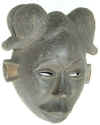TRIBAL AFRICAN ART
ANANG (ANNANG)
Nigeria
The Anang ethnic group inhabit the Nigerian province of Calabar
situated to the south of the Cross River, in the region of tropical forest. They have the
Ibibio, the Efik, the Eket and the Oron as nearest neighbors. The main resource of the
Anang is farming maize and yam. They live in villages led by a chief elected from the most
honorable heads of the important families and the Anang social life is regulated by three
secret societies, which incorporate masks into their annual ceremonies. A council of
elders assists the influential man who assumes the functions of chief of the group. Road
and river provided the primary routes for commerce, and was the way by which techniques
and know-how were also conveyed.
The most important of secret societies is the ekpo, which is
responsible for the cult of the ancestors, who are in turn responsible for the welfare of
the people.The masks of the Anang are the property of the ekpo, which once had
great political influence. The Anang are regarded as the most artistically prolific of the
Ibibio-speaking peoples in the Cross River area. The key masquerade performances take
place after the harvest, and are considered to mark the visit among humans of the
ancestral spirits (ekpo) represented by the masks. The art of eastern Nigerian
ethnic groups is in fact characterized by its absence of uniformity. In the same
community, one may encounter different styles employing an identical technique. It is
among the Anang that one finds the most theatrical staging of the masks, with the
intervention of a high number of persons. In addition to masks with grotesque features (idiok),
which are considered dangerous and may be viewed by ekpo members only, there are
masks embodying the “beautiful” spirit (mfon), which serve principally as
entertainment.
Visit our
Museum Store
